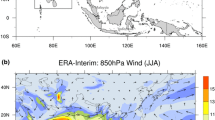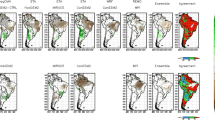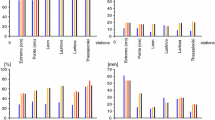Abstract
We investigate how well the variability of extreme daily precipitation events across the United Kingdom is represented in a set of regional climate models and the E-OBS gridded data set. Instead of simply evaluating the climatologies of extreme precipitation measures, we develop an approach to validate the representation of physical mechanisms controlling extreme precipitation variability. In part I of this study we applied a statistical model to investigate the influence of the synoptic scale atmospheric circulation on extreme precipitation using observational rain gauge data. More specifically, airflow strength, direction and vorticity are used as predictors for the parameters of the generalised extreme value (GEV) distribution of local precipitation extremes. Here we employ this statistical model for our validation study. In a first step, the statistical model is calibrated against a gridded precipitation data set provided by the UK Met Office. In a second step, the same statistical model is calibrated against 14 ERA40 driven 25 km resolution RCMs from the ENSEMBLES project and the E-OBS gridded data set. Validation indices describing relevant physical mechanisms are derived from the statistical models for observations and RCMs and are compared using pattern standard deviation, pattern correlation and centered pattern root mean squared error as validation measures. The results for the different RCMs and E-OBS are visualised using Taylor diagrams. We show that the RCMs adequately simulate moderately extreme precipitation and the influence of airflow strength and vorticity on precipitation extremes, but show deficits in representing the influence of airflow direction. Also very rare extremes are misrepresented, but this result is afflicted with a high uncertainty. E-OBS shows considerable biases, in particular in regions of sparse data. The proposed approach might be used to validate other physical relationships in regional as well as global climate models.






Similar content being viewed by others
Notes
With respect to splines with zero mean for the strength and vorticity dependence; as the splines calculated by VGAM have a mean different from zero, we actually approximated the offsets by time averages.
Note again that Fig. 3e, f in Maraun et al. (2011) show the same measures, and not measures based on the 90 and 10% quantiles as stated in that manuscript. The difference in the patterns is again marginal. Additionally, we have confused the two panels; panel (e) shows the relationship for anti-cyclonic airflow, panel (f) for cyclonic airflow.
References
Allan R, Tett S, Alexander L (2009) Fluctuations in autumn-winter severe storms over the British Isles: 1920 to present. Int J Climatol 29(3):357–371
Beniston M, Stephenson D, Christensen O, Ferro C, Frei C, Goyette S, Halsnaes K, Holt T, Jylhä K, Koffi B et al (2007) Future extreme events in European climate: an exploration of regional climate model projections. Clim Change 81:71–95
Busuioc A, von Storch H, Schnur R (1999) Verification of GCM-generated regional seasonal precipitation for current climate and of statistical downscaling estimates under changing climate conditions. J Clim 12:258–272
Christensen JH, Hewitson B, Busuioc A, Chen A, Gao X, Held I, Jones R, Kolli RK, Kwon WT, Laprise R, Rueda VM, Mearns L, Menéndez CG, Räisänen J, Rinke A, Sarr A, Whetton P (2007) Climate change 2007: the physical science basis. Contribution of working group I to the fourth assessment report of the intergovernmental panel on climate change, chapter regional climate projections. Cambridge University Press, Cambridge, United Kingdom and New York, NY, USA
Coles S (2001) An introduction to statistical modeling of extreme values. Springer, Berlin
Ekström M, Fowler HJ, Kilsby CG, Jones PD (2005) New estimates of future changes in extreme rainfall across the UK using regional climate model integrations. 2. Future estimates and use in impact studies. J Hydrol 300:234–251
Fowler HJ, Ekström M (2009) Multi-model ensemble estimates of climate change impacts on UK seasonal precipitation extremes. Int J Climatol 29:385–416
Fowler HJ, Ekström M, Blenkinsop S, Smith AP (2007) Estimating change in extreme European precipitation using a multimodel ensemble. J Geophys Res 112(D18):D18104
Fowler HJ, Ekström M, Kilsby CG, Jones PD (2005) New estimates of future changes in extreme rainfall across the UK using regional climate model integrations. 1. Assessment of control climate. J Hydrol 300:212–233
Frei C, Christensen JH, Déqué M, Jacob D, Jones RG, Vidale PL (2003) Daily precipitation statistics in regional climate models: evaluation and intercomparison for the european alps. J Geophys Res 108(D3):4124. doi:10.1029/2002JD002287
Friederichs P (2010) Statistical downscaling of extreme precipitation events using extreme value theory. Extremes 13:109–132
Haylock MR, Hofstra N, Klein Tank AMG, Klok EJ, Jones PD, New M (2008) A European daily high-resolution gridded data set of surface temperature and precipitation for 1950–2006. J Geophys Res 113:20119
Hofstra N, New M, McSweeney C (2010) The influence of interpolation and station network density on the distributions and trends of climate variables in daily gridded data. Clim Dyn 35:841–858
Jenkinson A, Collins F (1977) An initial climatology of gales over the North Sea. Technical report, Synoptic Climatology Branch Memorandum No. 62, Meteorological Office, Bracknell
Jones P, Hulme M, Briffa K (1993) A comparison of lamb circulation types with an objective classification scheme. Int J Climatol 13:655–663
Kalnay E, Kanamitsu M, Kistler R, Collins W, Deaven D, Gandin L, Iredell M, Saha S, White G, Woollen J, Zhu Y, Chelliah M, Ebisuzaki W, Higgins W, Janowiak J, Mo KC, Ropelewski C, Wang J, Leetmaa A, Reynolds R, Jenne R, Joseph D (1996) The NCEP/NCAR reanalysis project. BAMS 77:437–471
Kharin VV, Zwiers FW (2005) Estimating extremes in transient climate change simulations. J Clim 18:1156–1173
Kysely J, Plavcova E (2010) A critical remark on the applicability of e-obs european gridded temperature data set for validating control climate simulations. J Geophys Res 115:D23118
Maraun D, Osborn TJ, Gillett NP (2008) United Kingdom daily precipitation intensity: Improved early data, error estimates and an update from 2000 to 2006. Int J Climatol 28(6):833–842. doi:10.1002/joc.1672
Maraun D, Osborn TJ, Rust H (2011) The influence of synoptic airflow on UK daily precipitation extremes. Part I: observed spatio-temporal relations. Clim Dyn 36:261–275. doi:10.1007/s00382-009-0710-9
Maraun D, Rust HW, Osborn TJ (2009) The annual cycle of heavy precipitation across the UK: a model based on extreme value statistics. Int J Climatol 29:1731–1744. doi:10.1002/joc.1811
Maraun D, Rust HW, Osborn TJ (2010) Synoptic airflow and UK daily precipitation extremes. Development and validation of a vector generalised model. Extremes 13:133–153
Maraun D, Wetterhall F, Ireson AM, Chandler RE, Kendon EJ, Widmann M, Brienen S, Rust HW, Sauter T, Themeßl M, Venema VKC, Chun KP, Goodess CM, Jones RG, Onof C, Vrac M, Thiele-Eich I (2010) Precipitation downscaling under climate change. Recent developments to bridge the gap between dynamical models and the end user. Rev Geophys 48:RG3003
Marshall J, Kushnir Y, Battisti D, Chang P, Czaja A, Dickson R, Hurrell J, McCartney M, Saravanan R, Visbeck M (2001) North Atlantic climate variability: phenomena, impacts and mechanisms. Int J Climatol 21:1863–1898
Meehl GA, Stocker TF, Collins WD, Friedlingstein P, Gaye AT, Gregory JM, Kitoh A, Knutti R, Murphy JM, Noda A, Raper SCB, Watterson IG, Weaver AJ, and Zhao ZC (2007) Climate change 2007: the physical science basis. Contribution of working group I to the fourth assessment report of the intergovernmental panel on climate change, chapter global climate projections. Cambridge University Press, Cambridge, United Kingdom and New York, NY, USA
Osborn T, Conway D, Hulme M, Gregory J, Jones P (1999) Air flow influences on local climate: observed and simulated mean relationships for the United Kingdom. Clim Res 13:173–191
Perry M, Hollis D, Elms M (2009) The generation of daily gridded datasets of temperature and rainfall for the UK. Climate memorandum No. 24, UK Met Office
R Development Core Team (2006) R: a language and environment for statistical computing. R Foundation for Statistical Computing, Vienna, Austria. ISBN 3-900051-07-0
Randall DA, Wood RA, Bony S, Colman R, Fichefet T, Fyfe J, Kattsov V, Pittman A, Shukla J, Srinivasan J, Stouffer RJ, Sumi A, Taylor KE (2007) Climate change 2007: the physical science basis. Contribution of working group I to the fourth assessment report of the intergovernmental panel on climate change, chapter climate models and their evaluation. Cambridge University Press, Cambridge, United Kingdom and New York, NY, USA
Rivington M, Miller D, Matthews KB, Russell G, Bellocchi G, Buchan K (2008) Evaluating regional climate model estimates against site-specific observed data in the UK. Clim Change 88(2):157–185
Rust HW, Maraun D, Osborn TJ (2009) Modelling seasonality in extreme rainfall: a UK case study. Eur Phys J Special Topics 174:99–111
Taylor KE (2001) Summarizing multiple aspects of model performance in a single diagram. J Geophys Res 106(D7):7183–7192
Tebaldi C, Hayhoe K, Arblaster JM, Meehl GA (2006) Going to the extremes. An intercomparison of model-simulated historical and future changes in extreme events. Clim Change 79:185–211
Uppala SM, Källberg PW, Simmons AJ, Andrae U et al (2005) The ERA-40 reanalysis. Quart J Roy Meteorol Soc 131:2961–3012
van der Linden P and Mitchell JFB (2009) ENSEMBLES: Climate change and its impacts: summary of research and results from the ENSEMBLES project. Technical report, Met Office Hadley Centre
Wilby RL, O’Hare G, Barnsley N (1997) The North Atlantic oscillation and British isles climate variability. Weather 52:266–276
Wilks DS (2006) Statistical methods in the atmospheric sciences, 2 ed. Academic Press, Elsevier
Yee TW, Stephenson AG (2007) Vector generalized linear and additive extreme value models. Extremes 10:1–19
Yee TW, Wild CJ (1996) Vector generalized additive models. J R Stat Soc B 58:481–493
Acknowledgments
Douglas Maraun started the research for this manuscript at the Climatic Research Unit, receiving funding from the NERC Flood Risk From Extreme Events (FREE) programme (NE/E002412/1). We would like to thank Peter Stott and the UK Met Office for granting us permission to use the 5 km gridded daily precipitation data set. The software is written in R (R Development Core Team 2006) and based on the VGAM package by Thomas Yee and the EVD package by Alec Stephenson. The re-gridding of the UKMO 5km data set was done with the R package fields by Doug Nychka and colleagues.
Author information
Authors and Affiliations
Corresponding author
Electronic supplementary material
Below is the link to the electronic supplementary material.
Rights and permissions
About this article
Cite this article
Maraun, D., Osborn, T.J. & Rust, H.W. The influence of synoptic airflow on UK daily precipitation extremes. Part II: regional climate model and E-OBS data validation. Clim Dyn 39, 287–301 (2012). https://doi.org/10.1007/s00382-011-1176-0
Received:
Accepted:
Published:
Issue Date:
DOI: https://doi.org/10.1007/s00382-011-1176-0




